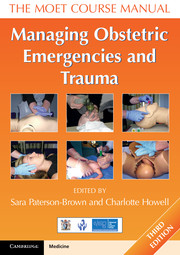Book contents
- Frontmatter
- Dedication
- Contents
- Working Group
- About the authors
- Acknowledgements
- Abbreviations
- Section 1 Introduction
- Section 2 Recognition
- Section 3 Resuscitation
- Section 4 Trauma
- Section 5 Other medical and surgical emergencies
- Section 6 Obstetric emergencies
- 24 Pre-eclampsia and eclampsia
- 25 Major obstetric haemorrhage
- 26 Caesarean section
- 27 Placenta accreta and retained placenta
- 28 Uterine inversion
- 29 Ruptured uterus
- 30 Ventouse and forceps delivery
- 31 Shoulder dystocia
- 32 Umbilical cord prolapse
- 33 Face presentation
- 34 Breech delivery and external cephalic version
- 35 Twin pregnancy
- 36 Complex perineal and anal sphincter trauma
- 37 Symphysiotomy and destructive procedures
- 38 Anaesthetic complications in obstetrics
- Section 7 Triage and transfer
- Section 8 Human issues
- Index
28 - Uterine inversion
- Frontmatter
- Dedication
- Contents
- Working Group
- About the authors
- Acknowledgements
- Abbreviations
- Section 1 Introduction
- Section 2 Recognition
- Section 3 Resuscitation
- Section 4 Trauma
- Section 5 Other medical and surgical emergencies
- Section 6 Obstetric emergencies
- 24 Pre-eclampsia and eclampsia
- 25 Major obstetric haemorrhage
- 26 Caesarean section
- 27 Placenta accreta and retained placenta
- 28 Uterine inversion
- 29 Ruptured uterus
- 30 Ventouse and forceps delivery
- 31 Shoulder dystocia
- 32 Umbilical cord prolapse
- 33 Face presentation
- 34 Breech delivery and external cephalic version
- 35 Twin pregnancy
- 36 Complex perineal and anal sphincter trauma
- 37 Symphysiotomy and destructive procedures
- 38 Anaesthetic complications in obstetrics
- Section 7 Triage and transfer
- Section 8 Human issues
- Index
Summary
Objectives
On successfully completing this topic, you will be able to:
recognise and manage uterine inversion.
Introduction
Reported incidence ranges from 1/2000 to 1/6400. Although it has often been thought to be related to mismanagement of the third stage, uterine inversion was found even in an institution that did not use the Crede's manoeuvre, where they strongly discourage vigorous cord traction and where oxytocin was not given until after placental separation. Brar et al. found a fundal placenta in the majority of women. Other associated obstetric conditions include a short cord, a morbidly adherent placenta and uterine anomalies.
Inversion of the uterus can be puerperal and nonpuerperal. However, chronic nonpuer peral uterine inversions are rare. In a study by Mwinyoglee et al., only 77 cases were reported; 75 (97.4%) were tumour-produced and 20% of these tumours were malignant.
Puerperal uterine inversions can follow vaginal delivery or occur at CS. Usual causes are cord traction before the uterus has contracted, but especially when there is a short umbilical cord, fundal insertion of placenta or an adherent placenta. Prompt understanding and repositioning by manual replacement will prevent further complications.
Immediate, nonsurgical measures are successful in the vast majority of cases of uterine inversion. The pooled experience of Brar et al. and Watson demonstrated only three laparotomies requiring surgical reposition out of a total of 102 uterine inversions.
- Type
- Chapter
- Information
- Managing Obstetric Emergencies and TraumaThe MOET Course Manual, pp. 333 - 338Publisher: Cambridge University PressPrint publication year: 2014

